2010 GMC SIERRA cooling
[x] Cancel search: coolingPage 285 of 630
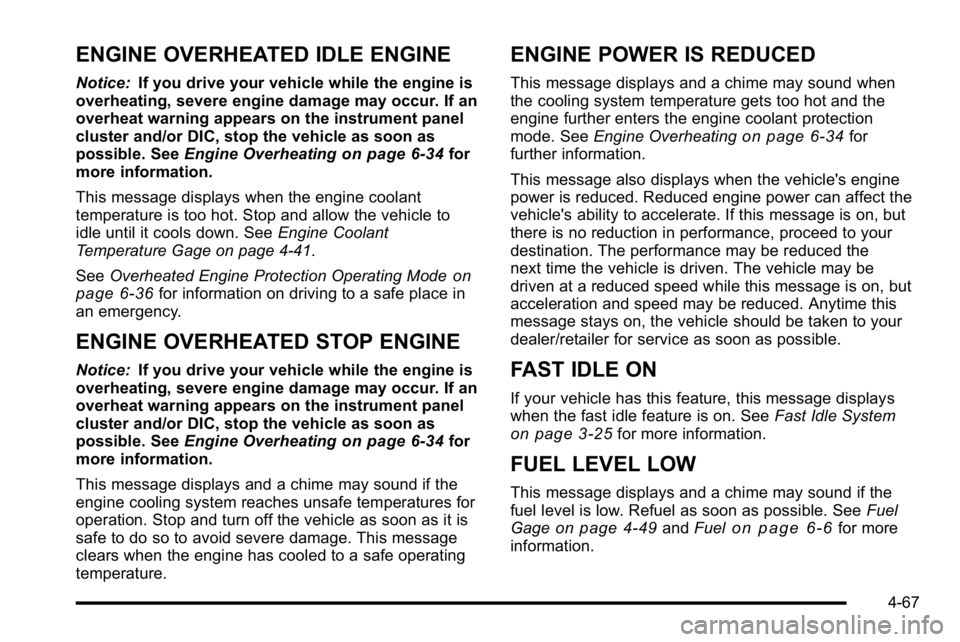
ENGINE OVERHEATED IDLE ENGINE
Notice:If you drive your vehicle while the engine is
overheating, severe engine damage may occur. If an
overheat warning appears on the instrument panel
cluster and/or DIC, stop the vehicle as soon as
possible. See Engine Overheating
on page 6‑34for
more information.
This message displays when the engine coolant
temperature is too hot. Stop and allow the vehicle to
idle until it cools down. See Engine Coolant
Temperature Gage on page 4‑41.
See Overheated Engine Protection Operating Mode
on
page 6‑36for information on driving to a safe place in
an emergency.
ENGINE OVERHEATED STOP ENGINE
Notice: If you drive your vehicle while the engine is
overheating, severe engine damage may occur. If an
overheat warning appears on the instrument panel
cluster and/or DIC, stop the vehicle as soon as
possible. See Engine Overheating
on page 6‑34for
more information.
This message displays and a chime may sound if the
engine cooling system reaches unsafe temperatures for
operation. Stop and turn off the vehicle as soon as it is
safe to do so to avoid severe damage. This message
clears when the engine has cooled to a safe operating
temperature.
ENGINE POWER IS REDUCED
This message displays and a chime may sound when
the cooling system temperature gets too hot and the
engine further enters the engine coolant protection
mode. See Engine Overheating
on page 6‑34for
further information.
This message also displays when the vehicle's engine
power is reduced. Reduced engine power can affect the
vehicle's ability to accelerate. If this message is on, but
there is no reduction in performance, proceed to your
destination. The performance may be reduced the
next time the vehicle is driven. The vehicle may be
driven at a reduced speed while this message is on, but
acceleration and speed may be reduced. Anytime this
message stays on, the vehicle should be taken to your
dealer/retailer for service as soon as possible.
FAST IDLE ON
If your vehicle has this feature, this message displays
when the fast idle feature is on. See Fast Idle System
on page 3‑25for more information.
FUEL LEVEL LOW
This message displays and a chime may sound if the
fuel level is low. Refuel as soon as possible. See Fuel
Gage
on page 4‑49and Fuelon page 6‑6for more
information.
4-67
Page 390 of 630

Driving in Water
{WARNING:
Driving through rushing water can be dangerous.
Deep water can sweep your vehicle downstream
and you and your passengers could drown. If it is
only shallow water, it can still wash away the
ground from under your tires, and you could lose
traction and roll the vehicle over. Do not drive
through rushing water.
Heavy rain can mean flash flooding, and flood waters
demand extreme caution.
Find out how deep the water is before driving through
it. Do not try it if it is deep enough to cover the wheel
hubs, axles, or exhaust pipe —you probably will not
get through. Deep water can damage the axle and
other vehicle parts. If the water is not too deep, drive slowly through it. At
faster speeds, water splashes on the ignition system
and the vehicle can stall. Stalling can also occur if you
get the tailpipe under water. If the tailpipe is under
water, you will never be able to start the engine. When
going through water, remember that when the brakes
get wet, it might take longer to stop. See
Driving in Rain
and on Wet Roads on page 5‑23.
After Off-Road Driving
Remove any brush or debris that has collected on the
underbody, chassis, or under the hood. These
accumulations can be a fire hazard.
After operation in mud or sand, have the brake linings
cleaned and checked. These substances can cause
glazing and uneven braking. Check the body structure,
steering, suspension, wheels, tires, and exhaust system
for damage and check the fuel lines and cooling system
for any leakage.
The vehicle requires more frequent service due to
off-road use. Refer to the Maintenance Schedule for
additional information.
5-22
Page 393 of 630

Hill and Mountain Roads
Driving on steep hills or through mountains is different
than driving on flat or rolling terrain. Tips for driving in
these conditions include:
.Keep the vehicle serviced and in good shape.
.Check all fluid levels and brakes, tires, cooling
system, and transmission.
.Going down steep or long hills, shift to a
lower gear.
{WARNING:
If you do not shift down, the brakes could get so
hot that they would not work well. You would then
have poor braking or even none going down a hill.
You could crash. Shift down to let the engine
assist the brakes on a steep downhill slope.
{WARNING:
Coasting downhill in N (Neutral) or with the
ignition off is dangerous. The brakes will have to
do all the work of slowing down and they could
get so hot that they would not work well. You
would then have poor braking or even none going
down a hill. You could crash. Always have the
engine running and the vehicle in gear when
going downhill.
.Stay in your own lane. Do not swing wide or cut
across the center of the road. Drive at speeds that
let you stay in your own lane.
.Top of hills: Be alert—something could be in your
lane (stalled car, accident).
.Pay attention to special road signs (falling rocks
area, winding roads, long grades, passing or
no-passing zones) and take appropriate action.
See Off-Road Driving
on page 5‑11for information
about driving off-road.
5-25
Page 420 of 630
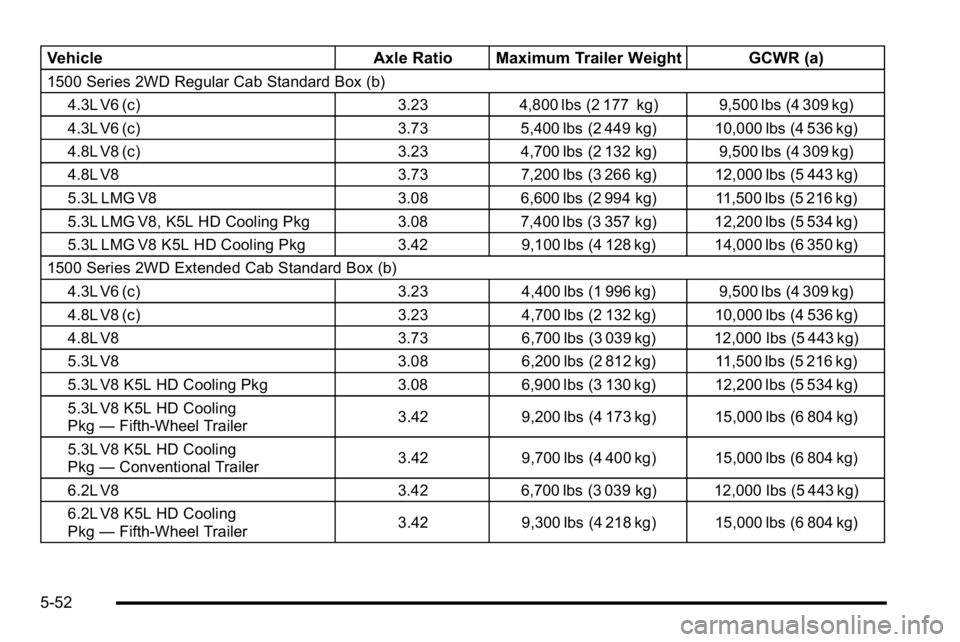
VehicleAxle Ratio Maximum Trailer Weight GCWR (a)
1500 Series 2WD Regular Cab Standard Box (b)
4.3L V6 (c) 3.23 4,800 lbs (2 177 kg) 9,500 lbs (4 309 kg)
4.3L V6 (c) 3.73 5,400 lbs (2 449 kg) 10,000 lbs (4 536 kg)
4.8L V8 (c) 3.23 4,700 lbs (2 132 kg) 9,500 lbs (4 309 kg)
4.8L V8 3.73 7,200 lbs (3 266 kg) 12,000 lbs (5 443 kg)
5.3L LMG V8 3.08 6,600 lbs (2 994 kg) 11,500 lbs (5 216 kg)
5.3L LMG V8, K5L HD Cooling Pkg 3.08 7,400 lbs (3 357 kg) 12,200 lbs (5 534 kg)
5.3L LMG V8 K5L HD Cooling Pkg 3.42 9,100 lbs (4 128 kg) 14,000 lbs (6 350 kg)
1500 Series 2WD Extended Cab Standard Box (b)
4.3L V6 (c) 3.23 4,400 lbs (1 996 kg) 9,500 lbs (4 309 kg)
4.8L V8 (c) 3.23 4,700 lbs (2 132 kg) 10,000 lbs (4 536 kg)
4.8L V8 3.73 6,700 lbs (3 039 kg) 12,000 lbs (5 443 kg)
5.3L V8 3.08 6,200 lbs (2 812 kg) 11,500 lbs (5 216 kg)
5.3L V8 K5L HD Cooling Pkg 3.08 6,900 lbs (3 130 kg) 12,200 lbs (5 534 kg)
5.3L V8 K5L HD Cooling
Pkg —Fifth-Wheel Trailer 3.42 9,200 lbs (4 173 kg) 15,000 lbs (6 804 kg)
5.3L V8 K5L HD Cooling
Pkg —Conventional Trailer 3.42 9,700 lbs (4 400 kg) 15,000 lbs (6 804 kg)
6.2L V8 3.42 6,700 lbs (3 039 kg) 12,000 lbs (5 443 kg)
6.2L V8 K5L HD Cooling
Pkg —Fifth-Wheel Trailer 3.42 9,300 lbs (4 218 kg) 15,000 lbs (6 804 kg)
5-52
Page 421 of 630
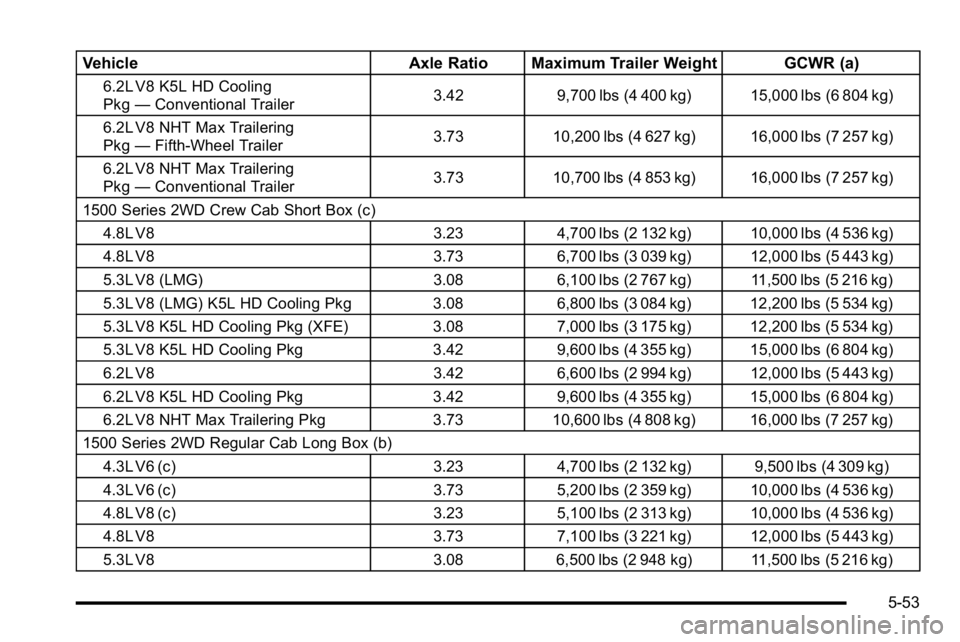
VehicleAxle Ratio Maximum Trailer Weight GCWR (a)
6.2L V8 K5L HD Cooling
Pkg—Conventional Trailer 3.42 9,700 lbs (4 400 kg) 15,000 lbs (6 804 kg)
6.2L V8 NHT Max Trailering
Pkg —Fifth-Wheel Trailer 3.73 10,200 lbs (4 627 kg) 16,000 lbs (7 257 kg)
6.2L V8 NHT Max Trailering
Pkg —Conventional Trailer 3.73 10,700 lbs (4 853 kg) 16,000 lbs (7 257 kg)
1500 Series 2WD Crew Cab Short Box (c) 4.8L V8 3.23 4,700 lbs (2 132 kg) 10,000 lbs (4 536 kg)
4.8L V8 3.73 6,700 lbs (3 039 kg) 12,000 lbs (5 443 kg)
5.3L V8 (LMG) 3.08 6,100 lbs (2 767 kg) 11,500 lbs (5 216 kg)
5.3L V8 (LMG) K5L HD Cooling Pkg 3.08 6,800 lbs (3 084 kg) 12,200 lbs (5 534 kg)
5.3L V8 K5L HD Cooling Pkg (XFE) 3.08 7,000 lbs (3 175 kg) 12,200 lbs (5 534 kg)
5.3L V8 K5L HD Cooling Pkg 3.42 9,600 lbs (4 355 kg) 15,000 lbs (6 804 kg)
6.2L V8 3.42 6,600 lbs (2 994 kg) 12,000 lbs (5 443 kg)
6.2L V8 K5L HD Cooling Pkg 3.42 9,600 lbs (4 355 kg) 15,000 lbs (6 804 kg)
6.2L V8 NHT Max Trailering Pkg 3.73 10,600 lbs (4 808 kg) 16,000 lbs (7 257 kg)
1500 Series 2WD Regular Cab Long Box (b) 4.3L V6 (c) 3.23 4,700 lbs (2 132 kg) 9,500 lbs (4 309 kg)
4.3L V6 (c) 3.73 5,200 lbs (2 359 kg) 10,000 lbs (4 536 kg)
4.8L V8 (c) 3.23 5,100 lbs (2 313 kg) 10,000 lbs (4 536 kg)
4.8L V8 3.73 7,100 lbs (3 221 kg) 12,000 lbs (5 443 kg)
5.3L V8 3.08 6,500 lbs (2 948 kg) 11,500 lbs (5 216 kg)
5-53
Page 422 of 630
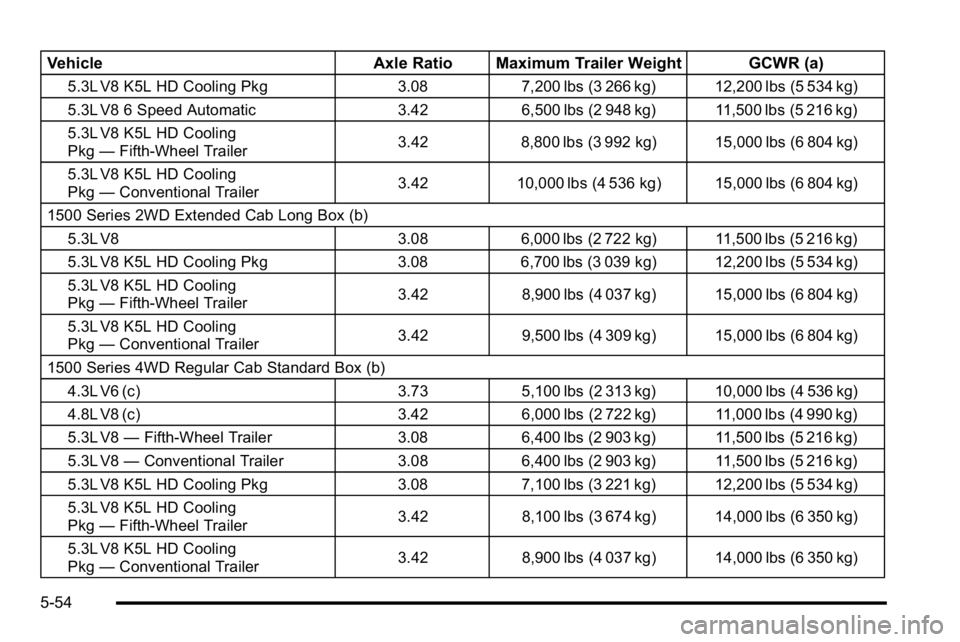
VehicleAxle Ratio Maximum Trailer Weight GCWR (a)
5.3L V8 K5L HD Cooling Pkg 3.087,200 lbs (3 266 kg) 12,200 lbs (5 534 kg)
5.3L V8 6 Speed Automatic 3.426,500 lbs (2 948 kg) 11,500 lbs (5 216 kg)
5.3L V8 K5L HD Cooling
Pkg —Fifth-Wheel Trailer 3.42
8,800 lbs (3 992 kg) 15,000 lbs (6 804 kg)
5.3L V8 K5L HD Cooling
Pkg —Conventional Trailer 3.42
10,000 lbs (4 536 kg) 15,000 lbs (6 804 kg)
1500 Series 2WD Extended Cab Long Box (b) 5.3L V8 3.086,000 lbs (2 722 kg) 11,500 lbs (5 216 kg)
5.3L V8 K5L HD Cooling Pkg 3.086,700 lbs (3 039 kg) 12,200 lbs (5 534 kg)
5.3L V8 K5L HD Cooling
Pkg —Fifth-Wheel Trailer 3.42
8,900 lbs (4 037 kg) 15,000 lbs (6 804 kg)
5.3L V8 K5L HD Cooling
Pkg —Conventional Trailer 3.42
9,500 lbs (4 309 kg) 15,000 lbs (6 804 kg)
1500 Series 4WD Regular Cab Standard Box (b) 4.3L V6 (c) 3.735,100 lbs (2 313 kg) 10,000 lbs (4 536 kg)
4.8L V8 (c) 3.426,000 lbs (2 722 kg) 11,000 lbs (4 990 kg)
5.3L V8 —Fifth-Wheel Trailer 3.086,400 lbs (2 903 kg) 11,500 lbs (5 216 kg)
5.3L V8 —Conventional Trailer 3.086,400 lbs (2 903 kg) 11,500 lbs (5 216 kg)
5.3L V8 K5L HD Cooling Pkg 3.087,100 lbs (3 221 kg) 12,200 lbs (5 534 kg)
5.3L V8 K5L HD Cooling
Pkg —Fifth-Wheel Trailer 3.42
8,100 lbs (3 674 kg) 14,000 lbs (6 350 kg)
5.3L V8 K5L HD Cooling
Pkg —Conventional Trailer 3.42
8,900 lbs (4 037 kg) 14,000 lbs (6 350 kg)
5-54
Page 423 of 630
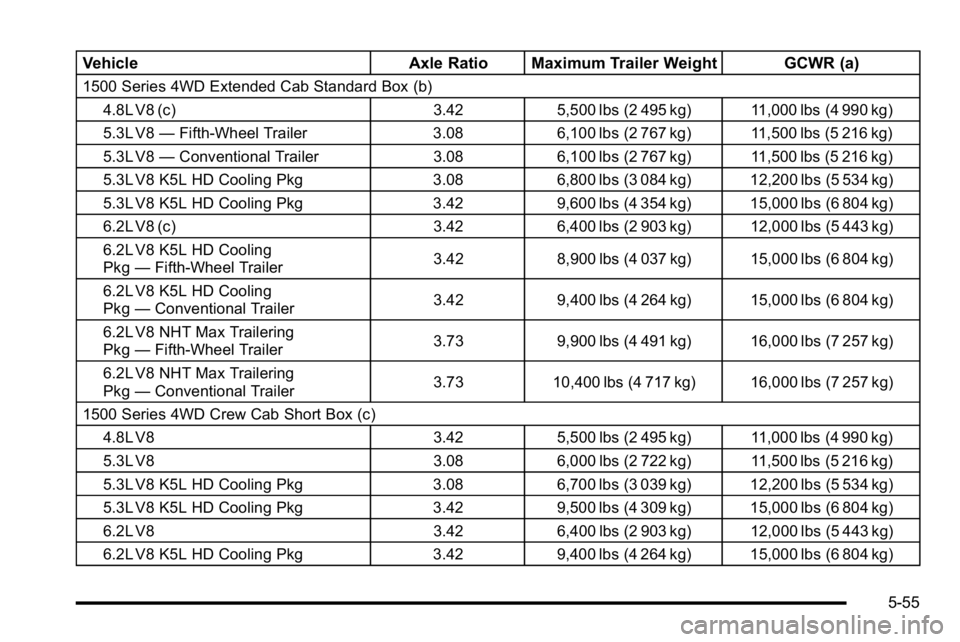
VehicleAxle Ratio Maximum Trailer Weight GCWR (a)
1500 Series 4WD Extended Cab Standard Box (b)
4.8L V8 (c) 3.42 5,500 lbs (2 495 kg) 11,000 lbs (4 990 kg)
5.3L V8 —Fifth-Wheel Trailer 3.08 6,100 lbs (2 767 kg) 11,500 lbs (5 216 kg)
5.3L V8 —Conventional Trailer 3.086,100 lbs (2 767 kg) 11,500 lbs (5 216 kg)
5.3L V8 K5L HD Cooling Pkg 3.086,800 lbs (3 084 kg) 12,200 lbs (5 534 kg)
5.3L V8 K5L HD Cooling Pkg 3.429,600 lbs (4 354 kg) 15,000 lbs (6 804 kg)
6.2L V8 (c) 3.426,400 lbs (2 903 kg) 12,000 lbs (5 443 kg)
6.2L V8 K5L HD Cooling
Pkg —Fifth-Wheel Trailer 3.42
8,900 lbs (4 037 kg) 15,000 lbs (6 804 kg)
6.2L V8 K5L HD Cooling
Pkg —Conventional Trailer 3.42
9,400 lbs (4 264 kg) 15,000 lbs (6 804 kg)
6.2L V8 NHT Max Trailering
Pkg —Fifth-Wheel Trailer 3.73
9,900 lbs (4 491 kg) 16,000 lbs (7 257 kg)
6.2L V8 NHT Max Trailering
Pkg —Conventional Trailer 3.73
10,400 lbs (4 717 kg) 16,000 lbs (7 257 kg)
1500 Series 4WD Crew Cab Short Box (c) 4.8L V8 3.425,500 lbs (2 495 kg) 11,000 lbs (4 990 kg)
5.3L V8 3.086,000 lbs (2 722 kg) 11,500 lbs (5 216 kg)
5.3L V8 K5L HD Cooling Pkg 3.086,700 lbs (3 039 kg) 12,200 lbs (5 534 kg)
5.3L V8 K5L HD Cooling Pkg 3.429,500 lbs (4 309 kg) 15,000 lbs (6 804 kg)
6.2L V8 3.426,400 lbs (2 903 kg) 12,000 lbs (5 443 kg)
6.2L V8 K5L HD Cooling Pkg 3.429,400 lbs (4 264 kg) 15,000 lbs (6 804 kg)
5-55
Page 424 of 630
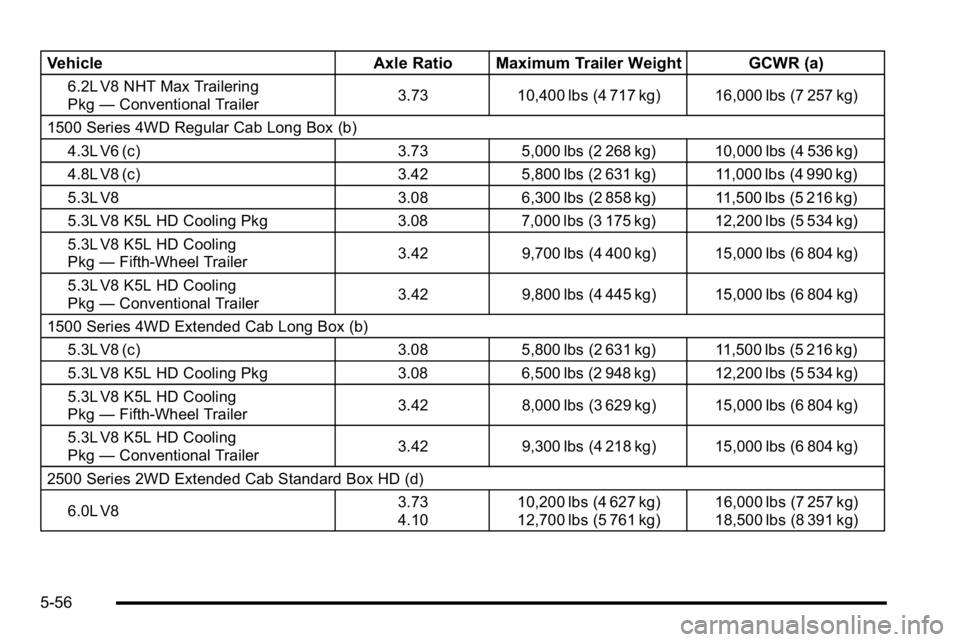
VehicleAxle Ratio Maximum Trailer Weight GCWR (a)
6.2L V8 NHT Max Trailering
Pkg—Conventional Trailer 3.73 10,400 lbs (4 717 kg) 16,000 lbs (7 257 kg)
1500 Series 4WD Regular Cab Long Box (b) 4.3L V6 (c) 3.73 5,000 lbs (2 268 kg) 10,000 lbs (4 536 kg)
4.8L V8 (c) 3.42 5,800 lbs (2 631 kg) 11,000 lbs (4 990 kg)
5.3L V8 3.08 6,300 lbs (2 858 kg) 11,500 lbs (5 216 kg)
5.3L V8 K5L HD Cooling Pkg 3.08 7,000 lbs (3 175 kg) 12,200 lbs (5 534 kg)
5.3L V8 K5L HD Cooling
Pkg —Fifth-Wheel Trailer 3.42
9,700 lbs (4 400 kg) 15,000 lbs (6 804 kg)
5.3L V8 K5L HD Cooling
Pkg —Conventional Trailer 3.42
9,800 lbs (4 445 kg) 15,000 lbs (6 804 kg)
1500 Series 4WD Extended Cab Long Box (b) 5.3L V8 (c) 3.085,800 lbs (2 631 kg) 11,500 lbs (5 216 kg)
5.3L V8 K5L HD Cooling Pkg 3.086,500 lbs (2 948 kg) 12,200 lbs (5 534 kg)
5.3L V8 K5L HD Cooling
Pkg —Fifth-Wheel Trailer 3.42
8,000 lbs (3 629 kg) 15,000 lbs (6 804 kg)
5.3L V8 K5L HD Cooling
Pkg —Conventional Trailer 3.42
9,300 lbs (4 218 kg) 15,000 lbs (6 804 kg)
2500 Series 2WD Extended Cab Standard Box HD (d) 6.0L V8 3.73
4.1010,200 lbs (4 627 kg)
12,700 lbs (5 761 kg) 16,000 lbs (7 257 kg)
18,500 lbs (8 391 kg)
5-56